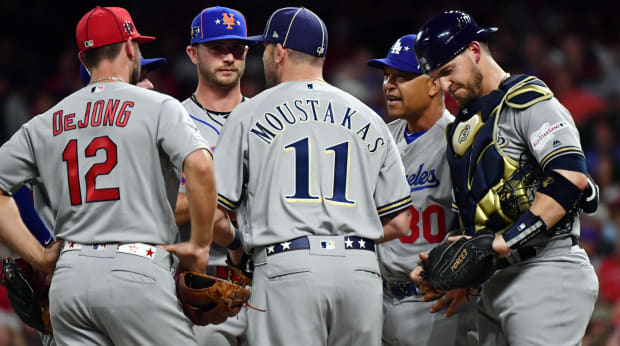Perhaps the primary virtue of the MLB All-Star Game is that every team gets a player.
There’s an argument that this is silly, that it waters down the event, that no one guy should have an easier path just because of the quality of his team. But statistical integrity has never been the point of the All-Star Game. (If it were, the starters would be decided by sorting a leaderboard, not organizing a fan election.) The game is more concerned with capturing a breadth of achievement across the league. And there’s something lovely about the fact that any kid, anywhere, can turn on the game and see a player from their favorite club. Maybe that player is sitting on the end of the bench, or tucked in the back of the bullpen, but he’s there all the same. Not every team deserves a starter. But every team deserves a representative.
And they should all be wearing their own team uniforms.
This was the case, of course, for decades. But in 2021, MLB began having players wear specially made All-Star jerseys, one for the AL and one for the NL. These jerseys existed previously: Players wore them for the All-Star workout or Home Run Derby and for promotional activities. Now, however, the jerseys are worn during the game itself, doing away with the tradition of players wearing their own uniforms. And even after a few years to adjust to the change? It sucks.

Ken Blaze/USA TODAY Sports
There was always a joy in looking across the field and seeing a patchwork of different uniforms. It was an aesthetic reflection of the purpose of the game: Here were all these players representing their various teams in their various jerseys. It was an automatic visual signal that you were not watching an ordinary game. Sure, the uniforms could occasionally clash. But that was charming far more than it was grating. It was something different! What better way to underscore that you were watching, say, an outfield with a Dodger, a Giant and a Padre than by having the players wear those actual uniforms? The All-Star Game brings players together in configurations we might otherwise never see. To have them wear their own jerseys puts a spotlight on that. The game is meant to be special. And even when that involves multiple players from one team—like this year, when the AL’s starting infield will feature not one, not two but three Rangers—the team uniforms more effectively display that, too. There’s no better way to grasp how many players a team has sent than by having them in their jerseys.
The All-Star Game’s magic lies in its possibilities. It offers combinations of players that would otherwise exist only in dreams. And there is a simple, enduring delight in seeing that manifest with players in their own team jerseys.
Compare all of that to the potential reasons for a single All-Star uniform. Cohesion? We have aesthetic cohesion on baseball fields for every other game of the year! Money? This seems far more likely. Another jersey for players to wear is another item for MLB to sell. (Though, again, past practice has shown it’s perfectly feasible to manufacture and sell the jerseys without requiring players to wear them for the actual game!) If players are wearing the All-Star jerseys during the All-Star Game, yes, it’s certainly easier to advertise and sell them. But isn’t it nice to think the Midsummer Classic might be about something more than that?
Think of the animating virtue of the game—a guy for every team and, in a better world, a team jersey for every guy.







